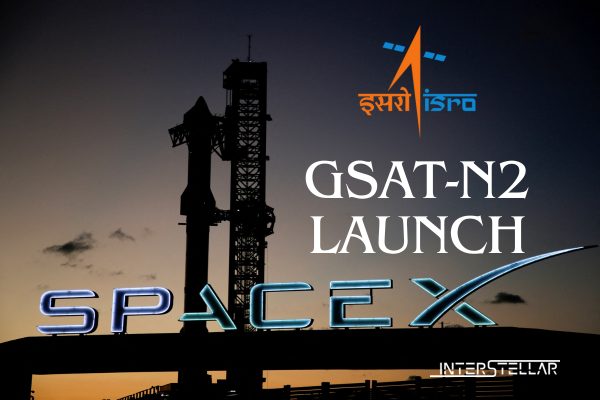SpaceX Launches GSAT-N2 Satellite: A Historic Collaboration Between ISRO and SpaceX
In a landmark achievement, SpaceX launches GSAT-N2 communication satellite for the Indian Space Research Organisation (ISRO) on November 18, 2024. The launch marked a significant milestone in international collaboration between two leading space organizations. A Falcon 9 rocket carrying the GSAT-N2 lifted off from Cape Canaveral Space Force Station at 1:31 PM EST (1831 GMT), deploying the satellite into a geosynchronous transfer orbit 34 minutes after liftoff.
This launch, the third for SpaceX in less than 24 hours, underscores the company’s commitment to efficiency and reliability in space missions. The Falcon 9’s first stage successfully returned to Earth, landing on the droneship “Just Read the Instructions” in the Atlantic Ocean. Notably, this marked the 19th mission for the particular booster used in this launch, demonstrating SpaceX’s expertise in reusable rocket technology.
Why ISRO Collaborated with SpaceX
The decision to partner with SpaceX represents a strategic shift for ISRO. Traditionally, the Indian space agency has relied on rockets operated by European company Arianespace to launch its heaviest satellites. However, with the GSAT-N2 satellite weighing 4,700 kilograms and requiring deployment in a geostationary orbit 22,236 miles (35,786 kilometers) above Earth, no Indian rocket currently has the capability to carry such a heavy payload to this destination.
By opting for SpaceX’s Falcon 9, ISRO leveraged a cost-effective and reliable solution. The collaboration also highlights the increasing globalization of the space industry, where commercial entities and government agencies work together to achieve ambitious goals. The partnership with SpaceX aligns with ISRO’s strategy to expand its commercial operations through NewSpace India Limited (NSIL), its commercial arm.
Specifications and Capabilities of GSAT-N2
The GSAT-N2 satellite, also known as GSAT-20, is a Ka-band High Throughput Satellite (HTS) designed and developed by NSIL. It is the second demand-driven satellite by the agency, aimed at enhancing broadband and in-flight connectivity (IFC) services across India. With advanced features, the satellite is poised to support India’s growing demand for high-speed internet and reliable communication services.
Key Features:
- High Throughput Communication Payload:
- Provides a total throughput of 48 Gbps.
- Features 32 user beams, including 8 narrow spot beams covering the Northeast region and 24 wide spot beams for the rest of India.
- Advanced Ka-band Technology:
- Utilizes Ka x Ka wideband transponders and spot beam architecture for increased efficiency.
- Employs frequency reuse techniques to boost system capacity.
- Deployable Reflectors:
- Equipped with three parabolic 2.5-meter deployable reflectors.
- Each reflector generates a spot beam using a single feed per beam configuration.
- Robust Spacecraft Design:
- Built on the Carbon Fiber Reinforced Polymer (CFRP)-based I4K bus.
- Compatible with multiple launch vehicles.
- Features a 14-year mission life.
- Thermal and Power Systems:
- Thermal control includes heat pipes, heaters, multi-layer insulation blankets, and thermal paints.
- Power is supplied through a fully regulated 70V bus with solar panels and Li-Ion batteries.
- Designed to meet a power requirement of 6 kW.
- Propulsion and Control:
- Unified bi-propellant chemical propulsion system using MON3 oxidizer and MMH fuel.
- 3-axis attitude control enabled by momentum/reaction wheels and thrusters.
- Sensors and Navigation:
- Equipped with Sun Sensors, Earth Sensors, an Inertial Reference Unit (IRU), and Star Sensors for precise attitude control.
Mission Objectives and Impact
The GSAT-N2 mission aims to provide high-speed internet connectivity, particularly in remote and underserved regions of India. Its capabilities will also enhance in-flight internet services, an area that has recently gained regulatory approval in Indian airspace. The satellite’s multi-beam architecture ensures optimized resource utilization, enabling a large subscriber base with small user terminals.
By employing advanced Ka-band technology and innovative payload configurations, GSAT-N2 represents a leap forward in satellite communication. The satellite’s operational life of 14 years ensures long-term service for critical applications, including e-governance, telemedicine, and disaster management.
A Step Forward for ISRO’s Commercial Operations
The GSAT-N2 mission underscores ISRO’s growing focus on demand-driven satellite missions through NSIL. As India’s space sector embraces commercialization, partnerships like the one with SpaceX pave the way for future collaborations that can drive innovation and expand India’s global footprint in the space industry.
Conclusion
SpaceX Launches GSAT-N2 which not only marks a technological achievement but also reflects the evolving dynamics of international cooperation in space exploration. As the satellite enters geostationary orbit and begins its operations, it promises to transform India’s communication landscape, bridging the digital divide and empowering millions with reliable broadband services. The collaboration between ISRO and SpaceX serves as a testament to the potential of global partnerships in advancing the frontiers of space technology.





